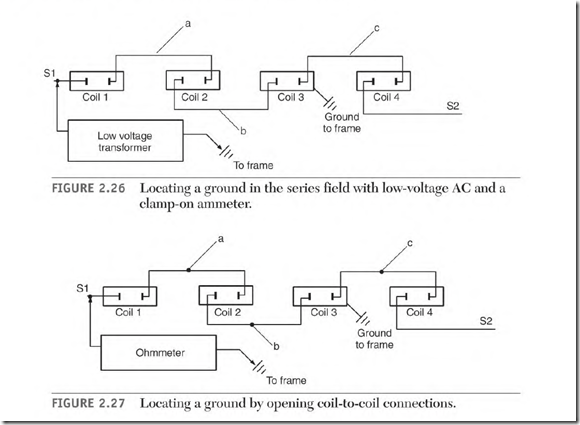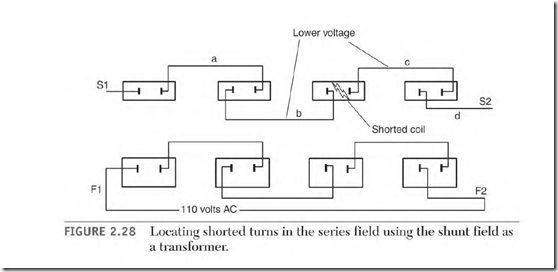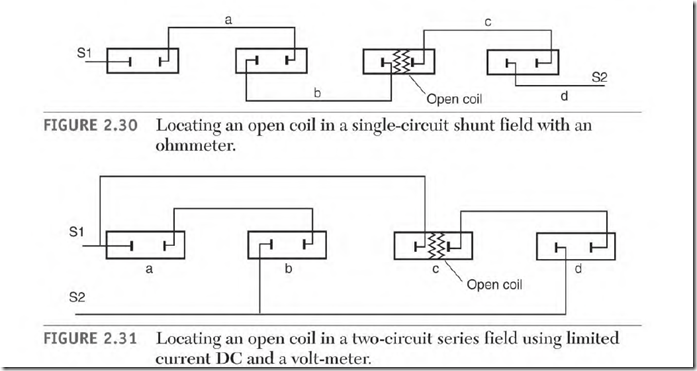If the brushes arc excessively and a faulty coil in the series field is suspected, run the machine without the series field. It will then operate as a shunt machine. (In a motor, RPM will drop with load increase; with a generator, voltage output will drop with load increase.) If brush arcing is normal, the series field has a problem.
The series field (Sl and S2) is a low-resistance circuit, with very few turns. Anywhere from 5 to 50 turns of large wire are common. The countervoltage in the armature controls the amperes through this circuit in a motor. The following problems occur in the series field:
![]() Short to the shunt field (covered earlier in the chapter under “Field Testing the Shunt Field”)
Short to the shunt field (covered earlier in the chapter under “Field Testing the Shunt Field”)
Ground to Frame Symptoms
If more than one coil is shorted to ground, the symptoms will be arcing at some or all brushes, and some series field coils will get hotter than others. A motor will have:
![]() Armature amperes higher than nameplate
Armature amperes higher than nameplate
In a generator, the following will occur:
Locating a Ground in the Series Field with a Clamp-On Ammeter and Limited AC
The AC voltage must be limited to 5 volts or under. A transformer and a (current-limiting) resistor should be used. The transformer should have enough power to provide a readable number of amperes.
Connect one transformer lead to the frame and the other to Sl (Fig. 2.26). Put the ammeter clamp around the coil-to-coil connections, starting at the nearest coil to S2. Check each connection until amperes show on the meter. Disconnect the faulty coil and check the remaining coils.
Locating a Ground in the Series Field with an Ohmmeter
Disconnect Sl and S2. Secure one probe of the ohmmeter to the frame of the machine, making good electrical contact. Fasten Sl to the other probe. If there is a low reading, open the coil-to-coil connections, starting at the
nearest coil to S2 (Fig. 2.27). When the reading goes to infinity, the ground is located in the last coil disconnected.
When two coils short to the frame, the turns (or coils) between them are bypassed. Bypassed turns or coils cause a severely unbalanced magnetic field. This causes some or all of the brushes to arc when the machine is loaded. If the coils aren’t tight on the pole iron, move all of them, with the ohmmeter attached to the frame and a lead. If the lead-to-frame reading is less than 50 megohms, the fields should be cleaned and/or heated and dried out.
Shorted Turns in the Series Field Symptoms
If the turns are shorted in the series field, the following can occur:
• Some or all brushes arc when the machine is loaded
• Loss of power
• Machine doesn’t react as it should to load changes
Locating Shorted Turns in the Series Field
Using AC and the Shunt Field
Apply 110 volts AC to Fl and F2 (Fig. 2.28). Pierce series field coil-to-coil connections, and read the voltage across each coil. A lower reading will be found across a shorted coil. A circulating current in the shorted turns of the series coil may raise the amperes in the shunt field. Don’t allow the shunt field to overheat.
Locating Shorted Turns Using the Voltage Drop Test and AC
An ohmmeter will not detect any difference between coils when only a few turns are shorted out (because of the circuit’s low resistance). A microhmmeter will work; the voltage drop test (using 2 to 5 volts AC) also will work (Fig. 2.29).
 Never apply more than 2 to 5 volts AC to the series field (Sl and S2). A destructively high voltage will be transformed into the shunt field.
Never apply more than 2 to 5 volts AC to the series field (Sl and S2). A destructively high voltage will be transformed into the shunt field.
Remove the insulation from the series field coil-to-coil connections. Apply 2 to 5 volts AC to Sl and S2. Read the voltage across each series field coil. A lower reading will be found across the shorted coil.
Locating an Open Circuit in Series Field
A one-circuit series field with an open circuit will have the following symptoms :
• A motor won’t start. The only complete circuit will be the shunt field.
• A generator won’t have a voltage output. Al and A2 will read full voltage. A two-circuit series field with an open circuit will have these symptoms:
• A motor will lose power, and some or all of the brushes will arc excessively (from magnetic unbalance).
• A generator will have full voltage output (at no load). As it is loaded, the voltage output will drop some, and some or all brushes will arc excessively.
Locating an Open in a One-Circuit Series Field
Using an Ohmmeter
An ohmmeter connected to Sl and S2 will read infinity (Fig. 2.30). Starting with an ohmmeter probe connected to Sl, pierce each coil connection from Sl to S2 until there is no reading. The reading across the faulty coil will be infinity.
Locating an Open in a Two-Circuit Series Field Using a Voltmeter
Remove the insulation from the series field coil-to-coil connections. Use a resistor that limits the amperes to the armature’s nameplate value, and apply DC voltage to Sl and S2 (Fig. 2.31).
Never apply the motor’s rated voltage to Sl and S2.
Check across each coil with a voltmeter. Full voltage will be found across the open coil. Coils a and b will show half voltage. Coil c will read full voltage and coil d will read zero voltage


